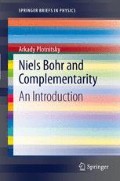Abstract
Bohr’s ultimate understanding of quantum phenomena and quantum mechanics gradually emerged, I argue here, under the impact of his exchanges with Einstein, beginning with those that took place in 1927 following the Como lecture and continuing into the 1940s. The double-slit experiment enters these exchanges at the outset never to leave them or Bohr’s thinking itself.
Access this chapter
Tax calculation will be finalised at checkout
Purchases are for personal use only
Notes
- 1.
While the double-slit experiment was not actually performed as a quantum experiment until later (in the case of electrons in 1960s), other quantum experiments that had been performed could be considered as equivalent to it with respect to the key features of quantum phenomena at stake, which enabled one to use the double-slit experiment as a thought experiment. Cf., Bohr’s comments in his reply to EPR (Bohr 1935, p. 698, n.). This is not unusual. That the EPR experiment, as originally proposed by EPR, cannot in principle be performed in a laboratory has never put in doubt its legitimacy for the theoretical arguments based on it. Related experiments, based on Bohm’s version of the EPR experiment for spin have been performed, as were experiments statistically approximating the EPR experiment.
- 2.
Heisenberg addressed this subject, which he saw as important in clearing up misconceptions about quantum mechanics, in his response to the EPR argument (Heisenberg 1935).
- 3.
For an excellent nontechnical but conceptually important account of quantum electrodynamics, “the strange theory of electrons and photons,” see (Feynman 1985).
- 4.
Even in Bohmian theories, where both concepts are used in describing the behavior of quantum objects, they are not fused in a single entity: a wave accompanies and guides a particle, following de Broglie’s idea, inspired by Einstein’s earlier suggestion, discarded by Einstein himself.
- 5.
This argument relates to a thorny problem of the transition from the quantum to the classical domain—a problem addressed, with, I would argue, at most a limited success, by decoherence theories (e.g., Zurek 2003; Schlosshauer 2007).
- 6.
These traces are not really “points”: they appear as “dots” only at a low resolution, while actually comprising millions of atoms (Ulfbeck and Bohr 2001; Bohr, Mottelson and Ulfbeck 2004). These authors target the use of the idea of particles, including by Niels Bohr (one of the authors is Aage Bohr, Niels Bohr’s son), in my view, mistakenly. In particular, they disregard Bohr’s argument that the concept of particle, just as that of wave, is an abstraction and (this is crucial) an abstraction of a different kind than in classical physics.
- 7.
Wheeler appears to assume that each photon passes through both slits in the corresponding setup, or more accurately makes an equivalent assumption in his experiment, which is a version of the beam-splitter experiment. That Wheeler subscribes to the idea is intriguing because he is among the stronger advocates of Bohr’s views, which appear to be in conflict with this idea. As explained above, Bohr sometimes applies the term “wave” to individual particles in the symbolic sense. I do not believe, however, that statements to the effect that individual electrons or photons actually, physically behave in a wave-like manner (or pass through more than one slit) ever occur in Bohr. On the other hand, statements at least suggesting the opposite are found throughout his writings (e.g., Bohr 1949, PWNB 2, pp. 46–47; Bohr 1935, p. 697).
- 8.
In quantum theory, elementary particles are idealized as zero-dimensional, point-like objects, even though they are assigned masses. Such objects can be given a rigorous mathematical meaning, but not a rigorous physical meaning. It is true that this type of point-like (mathematical) idealization of physical objects is also used in classical physics. There, however, this idealization allows one to approximate the actual behavior of the objects considered and, on the basis of this descriptive approximation, to make excellent predictions concerning this actual behavior. The physical objects themselves thus considered may be, and usually are, assumed to have extension, the property that has defined physical objects or, more generally, material bodies (res extensa) at least since Descartes. In the case of quantum objects, such an assumption is difficult to sustain. For example, in the case of electrons it leads to a well-known contradiction with classical electrodynamics, since, if assumed to have extension, an electron would be torn apart by its negative charge. This circumstance led to the idealization of the electron as a dimensionless point-like object even before quantum mechanics.
- 9.
As I noted earlier, we measure the momentum in a given direction, and the uncertainty relations apply to this momentum and the corresponding coordinate. In the uncertainty relations for the position and the momentum associated with a quantum object in 3D space, each quantity will have three components defined by the chosen coordinate system.
Author information
Authors and Affiliations
Corresponding author
Rights and permissions
Copyright information
© 2013 Arkady Plotnitsky
About this chapter
Cite this chapter
Plotnitsky, A. (2013). 1931. “The Space–Time Continuity and Atomic Physics” (the Bristol Lecture): Quantum Phenomena and the Double-Slit Experiment. In: Niels Bohr and Complementarity. SpringerBriefs in Physics. Springer, New York, NY. https://doi.org/10.1007/978-1-4614-4517-3_6
Download citation
DOI: https://doi.org/10.1007/978-1-4614-4517-3_6
Published:
Publisher Name: Springer, New York, NY
Print ISBN: 978-1-4614-4516-6
Online ISBN: 978-1-4614-4517-3
eBook Packages: Physics and AstronomyPhysics and Astronomy (R0)

